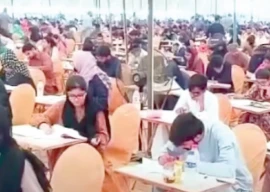
In the 21st century it is hard to imagine that there are still places that are undocumented but Damrilah in Sindh is one such site that has been puzzling historians and archeologists for years.
“Damrilah is one of the puzzles of Sindh. Nobody could locate the place and it was just known that it was somewhere between Daybul and Thatta. I never thought I would find it,” said Dr Monique Kervran, a French archaeologist. She has spent nearly two decades of her life excavating different parts of Sindh in an effort to piece together its history to create a fuller picture of how the region has transformed over centuries.
On Wednesday, she presented her findings on behalf of the French mission she was representing at Mohatta Palace. She relied on balloon photography and an innovative technique using a kite for photography that has never been used before in Pakistan. With them, she managed to locate Damrilah and find remains of a mosque in the area that was initially identified by two other historians.
“Relying on historical sources and photography I managed to find traces of the mosque,” says Kervran, but added that little can be salvaged. “Most of the town is now under silt from the Indus Delta.”
The mosque Kervran is referring to is believed to have been built by Jalaluddin Khwarizm Shah when he invaded the area from nearby Thatta around the 13th century. Kervran says that by drawing on historical sources and comparing the relics found at the site, it is estimated that it could have been built anywhere between the 7th and 13th centuries.
At the moment two large pieces of the mosque have been found with inscriptions in Kufic script. But the pieces are not in a good enough condition, or big enough to be able to make out what was written on them.
“These two pieces were found in the ravine right near the site of the mosque and for the rest of the ruins we’ll have to go digging in the sea or [they] are buried under silt,” said the resigned but pragmatic Kervran. “But we also have portions of the base of the columns which has allowed us to draft a rough map of what the masjid looked like.”
A structure in Kabirwala, a mausoleum in Muzaffargarh, and another relic in Chichh, Afghanistan were cited as contemporaneous structures by Kervran who feels that they are further evidence on when the mosque may have been built and possibly by whom.
“The style is typical of relics found in Afghanistan, Iran and Central Asia,” she said.
To strengthen her hypothesis, Kervran gave examples of different historians who had written of Damrilah, albeit using different spellings, and of two historians who never mentioned it and why they didn’t. She admitted that the mystery she found hardest to solve was why Ibn-e-Battuta the historian never mentioned this in his writings despite his prolific documentation of nearby areas. “I just don’t know, it’s very difficult to figure out why, it can’t be explained.”
Renowned archaeologist Kaleemullah Lashari was in attendance at the talk. “The Indus Delta portion of Sindh is such an enigmatic area and this is historically significant because it helps to put together the sequence of history for the area,” he said. The area has been known to be a destroyer of ports and it is necessary to be able to name and sequence the towns that have existed here before us to get a picture of history, he said.
When it comes to Damrilah, the entire mystery will probably never be solved, despite the efforts of Pakistani and foreign archaeologists.
“Nothing more can be done for Damrilah, it is impossible because it is stuck under silt. Sea erosion is eating it up and more work can’t be done, I’m very sorry,” said Kervran, ensuring that the mystery of Damrilah perseveres.
Published in The Express Tribune, March 15th, 2012.
COMMENTS (4)
Comments are moderated and generally will be posted if they are on-topic and not abusive.
For more information, please see our Comments FAQ





1732176172-0/Untitled-design-(8)1732176172-0-270x192.webp)
1732175528-2/Untitled-design-(5)1732175528-2-270x192.webp)










OMG this is so sad :(.......i wish our !@#$ up politicians did some abt it !!!! awesome women........i just feel sad that we cant do any thing to protect it !
Great work from another foreigner, as Pakistani archaeologists have no support to do this type of work. The archaeologist who discovered Moenjodaro said if this was in Europe, we would put the whole city under glass. The relevant government departments should dismantle all dams on Sindhu darya so that the river can flow freely and stop sea intrusion. They should also kick out squatters living in historical Puca Qila in Hyderabad and other historical sites. A people who don't know their past, will have no future.
@Acorn Guts True that conservation is a "non-issue" in Pakistan where political circus is really the "in" thing and this is also true that our general behavior towards ancient sites has been discouraging BUT your statement "safer under the soil than out" ...and ..."Let it remain under silt and rot away, this way we'll have it for longer" is true internationally... have a look at the issues being faced by conservationists for Pompeii, Italy:
http://news.google.com/newspapers?nid=1876&dat=19770308&id=m4EsAAAAIBAJ&sjid=Vs0EAAAAIBAJ&pg=6776,1735505
Safer under the soil than out. This is how we roll in Pakistan when it comes to archaeology. Let it remain under silt and rot away, this way we'll have it for longer.